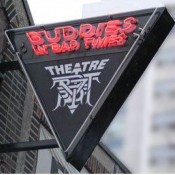Montreal-based dance artist [color]Priscilla Guy[/color] returns to The Rhubarb Festival this year with another public space intervention, [color]Moving Installations[/color]. Since she’s as close as we’ve got to a resident expert, we asked for her thoughts on the idea of Performance & Public Space.
When I first participated in Rhubarb in 2011, I was presenting Intersection Project, a spontaneous group performance in Toronto’s urban landscape with Kate Nankervis, co-founder of the project. I’m originally from Sherbrooke, Québec, and lived in Montreal for years, however at the time of creation, I was living in Toronto and enjoying discovering the city through my art interventions. Our performances at Rhubarb were part of a 10-performance series lasting from to September 2010 to June 2011 including about 15 to 25 dancers every month, at different street intersections in the city.
This year, I present Moving Installations, a site specific performance for 4 dancers, produced by Mandoline Hybride (the company I founded 5 years ago), which infiltrates coffee shops and book stores around the Buddies neighbourhood. Although the two projects are distinct, they share similarities, such as my great desire to belong to the places I live in, to challenge people’s everyday life by transforming their landscapes, etc. I would like to share an excerpt of a text I wrote in 2011 before we performed the last Intersection Project performance in June 2011.
Strangely enough, this text could fit perfectly with what happened in Quebec and especially in Montreal in 2012, starting with the student strike against the hike, continuing with people, residents, grand-parents and children going out in the streets every night with their “casseroles” to claim their presence, opinions and rebellion. Maybe that is what it is for me, to perform in public spaces: a form of rebellion against the routine, the regulations and the “etiquette”. We ask how we conform to expected behavior or not and how to challenge people’s assumptions without drastically confronting them, or putting a judgments on them. Across (quite) soft artistic interventions, I still witness how it changes the room, the people who are there for the day and, most of all, how it changes “my” day, and the way I interact with the world.
“Public spaces barely exist nowadays. We faced the challenge and reality of being a group of dancers in spaces that we thought were public but that, in the end, were spaces “reserved” for someone else, for something else, or at least not for us, dancing. The idea often comes up that every space and everything in the city belongs to someone, and scares me.
When performing in downtown Toronto with our Intersection artists, I always felt we were doing something important and relevant. However, when you look at it, we simply performed pedestrian movement scores in a large group. Nothing happens before, nothing happens after, we don’t advertise it, we don’t make it a spectacle, we don’t make it fancy and flashing; it happens and disappears. Of course we do gather after every performance and invite people to join us to discuss and share thoughts, as well as document the performances and post videos and photos of it. But nothing drastic happens because of it. So why do I feel this is so important? Is there any direct outcome from what we are doing?
(…)
When I perform with Intersection Project, I feel extremely powerful. It is one of the greatest feelings I’ve ever gotten out of a performance I am involved in. I feel powerful because I feel free. Free of what? Of regulations, perhaps. It gives me the feeling that I am not too small for my city, that I do have power over what happens in it and how I feel I am someone who can decide for themselves how to live in the city. It is a feeling I rarely have the rest of the time. It seems to me the city is so big and overwhelming, and I’m dependant on everything in it. I am not the one making decisions.
But when I am there, lying on concrete blocks in the middle of the street next to St-Lawrence market with my fellow Intersection Project performers, I feel free. Nobody forces me to be there and do this. (…) Being there is a statement; it says the city belongs to me, too and not only to business people, not only to Rob Ford, not only to the organizers of the G20. The city belongs to me too, because I live in it. It is where I am every day.
When I am there, running up the stairs at the CN Tower before crashing onto the cold ground with 15 other people, I feel free. Because I am part of the larger landscape and it seems to me I am providing the people watching with a glimpse of what we can do with our city, if we want to. It happened often that people came to us to say they liked watching the performance because it reminds them of this or that…that in itself is enough for me to justify doing it.
When I am there, improvising pirouettes at Queen’s Park’s intersection, creating traffic because cars are slowing down and drivers try to see what is happening with us (20 performers swaying from side to side and turning all around), I feel that it might be enough, just to be there and state our presence in the city.
Last month, performing with 8 courageous dancers under pouring rain at the corner of Bloor Street and Avenue Road, I thought that it was pretty amazing that we were performing despite the rain. It is a statement too: people question what we are doing most of the time, because our performance does not belong to their everyday life, but when we do it under the rain, it brings up the level of questioning to a higher degree!”
-Portrait of a city | Part III, by Priscilla Guy, April 27th, 2011

